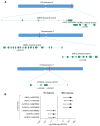Platinum Drug Sensitivity Polymorphisms in Stage III Non-small Cell Lung Cancer With Invasion of Mediastinal Lymph Nodes
- PMID: 32859637
- PMCID: PMC7472447
- DOI: 10.21873/cgp.20215
Platinum Drug Sensitivity Polymorphisms in Stage III Non-small Cell Lung Cancer With Invasion of Mediastinal Lymph Nodes
Abstract
Background/aim: Patients with stage IIIA (N2) non-small cell lung cancer (NSCLC) with no progression after induction chemotherapy are usually selected for surgery. Nowadays, response to chemotherapy is not predictable. We aimed to identify genomic predictive markers for response to induction chemotherapy in stage IIIA (N2) NSCLC patients.
Patients and methods: Whole-exome sequencing (WES) was performed on samples from 11 patients with no response after induction chemotherapy and 6 patients with documented pathological response, admitted to the Hotel Dieu Hospital, Paris or Allegemeines Krakenhaus University, Vienna.
Results: A higher alternative allele frequency was found on SENP5, rs63736860, rs1602 and NCBP2, rs553783 in the non-responder group, and on RGP1, rs1570248, SLFN12L, rs2304968, rs9905892, and GBA2, rs3833700 in the responder group.
Conclusion: These polymorphisms contribute to inter-individual sensibility to chemotherapy response. Interrogation of these genetic variations may have potential applicability when deciding the treatment strategy for patients with stage III NSCLC (N2).
Keywords: NSCLC; Whole-exome sequencing; platinum sensitivity.
Copyright© 2020, International Institute of Anticancer Research (Dr. George J. Delinasios), All rights reserved.
Conflict of interest statement
The Authors declare no conflicts of interest.
Figures




Similar articles
-
Molecular Markers for Long-term Survival in Stage IIIA (N2) NSCLC Patients.Cancer Genomics Proteomics. 2022 Jan-Feb;19(1):94-104. doi: 10.21873/cgp.20306. Cancer Genomics Proteomics. 2022. PMID: 34949662 Free PMC article.
-
Current status of induction treatment for N2-Stage III non-small cell lung cancer.Gen Thorac Cardiovasc Surg. 2014 Nov;62(11):651-9. doi: 10.1007/s11748-014-0447-1. Epub 2014 Jul 18. Gen Thorac Cardiovasc Surg. 2014. PMID: 25355643 Review.
-
Outcome of Patients With pN2 "Potentially Resectable" Nonsmall Cell Lung Cancer Who Underwent Surgery After Induction Chemotherapy.Semin Thorac Cardiovasc Surg. 2016 Summer;28(2):593-602. doi: 10.1053/j.semtcvs.2015.12.001. Epub 2015 Dec 10. Semin Thorac Cardiovasc Surg. 2016. PMID: 28043483
-
Prognostic potential of ERCC1 protein expression and clinicopathologic factors in stage III/N2 non-small cell lung cancer.J Cardiothorac Surg. 2013 Jun 10;8:149. doi: 10.1186/1749-8090-8-149. J Cardiothorac Surg. 2013. PMID: 23759026 Free PMC article.
-
Neoadjuvant therapy for resectable non-small cell lung cancer with mediastinal lymph node involvement.Thorac Surg Clin. 2008 Nov;18(4):403-15. doi: 10.1016/j.thorsurg.2008.07.004. Thorac Surg Clin. 2008. PMID: 19086609 Review.
Cited by
-
Comprehensive investigation in oncogenic functions and immunological roles of NCBP2 and its validation in prostate cancer.Transl Oncol. 2024 Sep;47:102049. doi: 10.1016/j.tranon.2024.102049. Epub 2024 Jul 3. Transl Oncol. 2024. PMID: 38964031 Free PMC article.
-
Integrated Analysis of Tumor Mutation Burden and Immune Infiltrates in Hepatocellular Carcinoma.Diagnostics (Basel). 2022 Aug 8;12(8):1918. doi: 10.3390/diagnostics12081918. Diagnostics (Basel). 2022. PMID: 36010268 Free PMC article.
-
Molecular Markers for Long-term Survival in Stage IIIA (N2) NSCLC Patients.Cancer Genomics Proteomics. 2022 Jan-Feb;19(1):94-104. doi: 10.21873/cgp.20306. Cancer Genomics Proteomics. 2022. PMID: 34949662 Free PMC article.
-
Identification of DNA repair-related genes predicting pathogenesis and prognosis for liver cancer.Cancer Cell Int. 2021 Jan 30;21(1):81. doi: 10.1186/s12935-021-01779-1. Cancer Cell Int. 2021. PMID: 33516217 Free PMC article.
-
SENP5 promotes homologous recombination-mediated DNA damage repair in colorectal cancer cells through H2AZ deSUMOylation.J Exp Clin Cancer Res. 2023 Sep 8;42(1):234. doi: 10.1186/s13046-023-02789-9. J Exp Clin Cancer Res. 2023. PMID: 37684630 Free PMC article.
References
-
- Gray JE, Villegas A, Daniel D, Vicente D, Murakami S, Hui R, Kurata T, Chiappori A, Lee KH, Cho BC, Planchard D, Paz-Ares L, Faivre-Finn C, Vansteenkiste JF, Spigel DR, Wadsworth C, Taboada M, Dennis PA, Ozguroglu M, Antonia SJ. Three-year overall survival with durvalumab after chemoradiotherapy in stage III NSCLC-update from pacific. J Thorac Oncol. 2020;15(2):288–293. doi: 10.1016/j.jtho.2019.10.002. - DOI - PMC - PubMed
-
- Santana-Davila R, Szabo A, Arce-Lara C, Williams CD, Kelley MJ, Whittle J. Cisplatin versus carboplatin-based regimens for the treatment of patients with metastatic lung cancer. An analysis of veterans health administration data. J Thorac Oncol. 2014;9(5):702–709. doi: 10.1097/JTO.0000000000000146. - DOI - PMC - PubMed
-
- Grigoroiu M, Tagett R, Draghici S, Dima S, Nastase A, Florea R, Sorop A, Ilie V, Bacalbasa N, Tica V, Laszlo V, Mansuet-Lupo A, Damotte D, Klepetko W, Popescu I, Regnard JF. Gene-expression profiling in non-small cell lung cancer with invasion of mediastinal lymph nodes for prognosis evaluation. Cancer Genomics Proteomics. 2015;12(5):231–242. - PubMed
Publication types
MeSH terms
Substances
LinkOut - more resources
Full Text Sources
Medical
